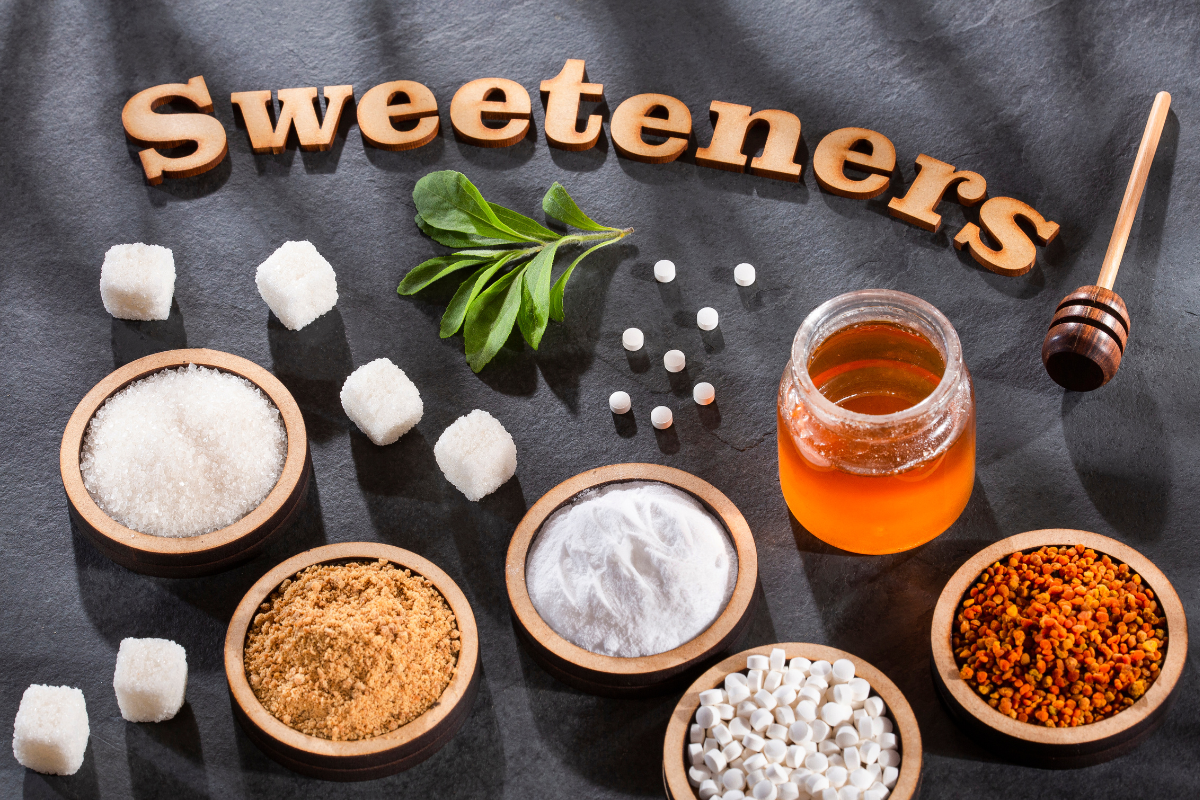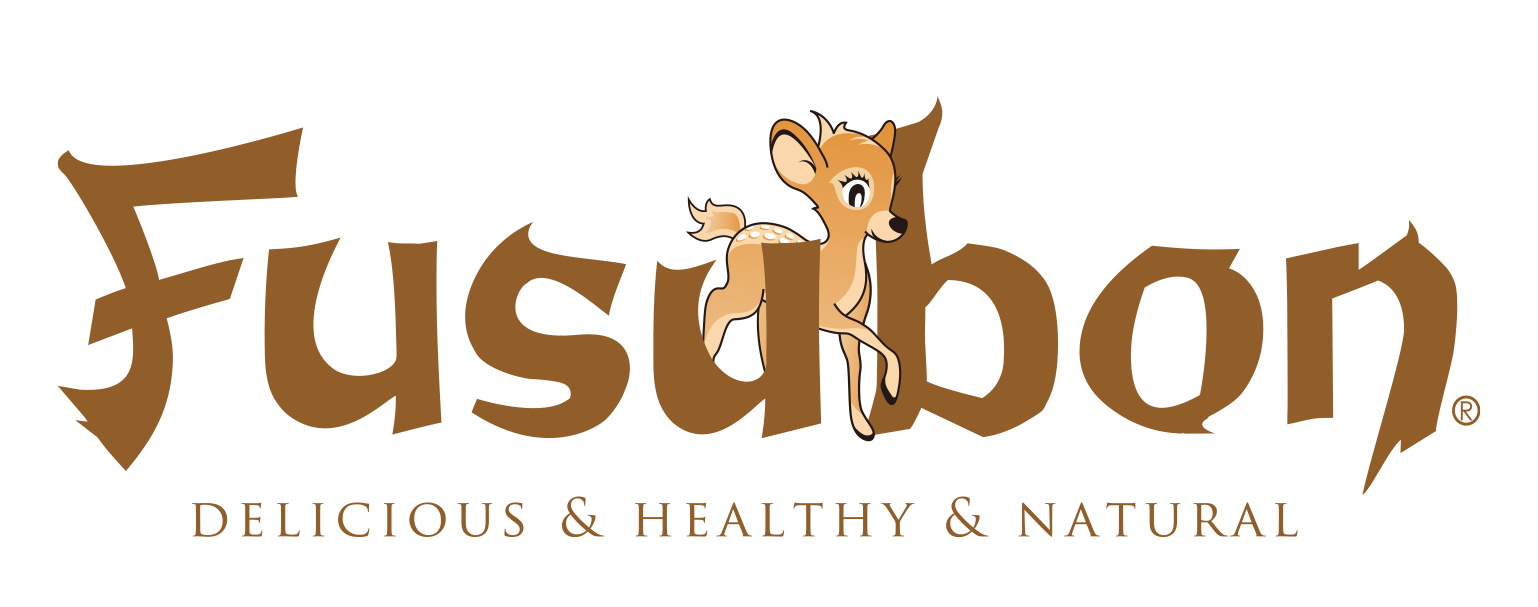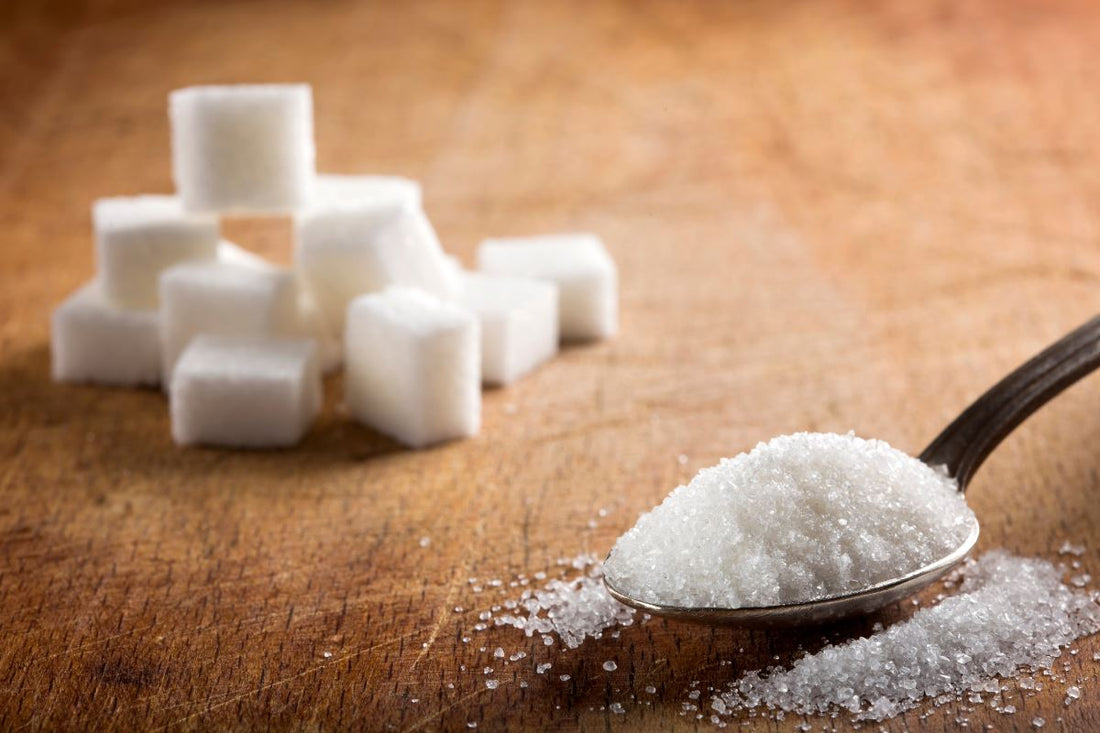Hello, this is Fusbon owner.
Today, I would like to explain the difference between carbohydrates and sugars, as well as sugars and sweeteners in general, and how to read the sugar content in overseas products.
It seems simple, but it takes some time to master.
So I'll explain it step by step.
Let's start by looking at this commonly used Venn diagram:
The difference between sugars and carbohydrates
 As you can see in this Venn diagram, carbohydrates = sugar + dietary fiber .
As you can see in this Venn diagram, carbohydrates = sugar + dietary fiber .
Carbohydrates = "sugars" + "sugars with three or more sugars + sugar alcohols + artificial sweeteners + natural sweeteners."
From the above, it is easy to see that carbohydrates are not the same as sugars.
However, I think there are many people who do not know what monosaccharides, disaccharides, trisaccharides or higher sugars, sugar alcohols, artificial sweeteners, and natural sweeteners are, and which specific substances fall into these categories, so I will explain them one by one.
What are Monosaccharides

Monosaccharides are exactly what the name suggests: a single sugar, the smallest unit of sugar.
Monosaccharides are also classified into smaller groups based on the number of carbon atoms they contain, with the most well-known being glucose (dextrose), fructose (fruit sugar), galactose, and tagatose.
Monosaccharides cannot be broken down further in the form of sugar, so they are the sugars that cause blood sugar levels to rise the fastest (high GI value).
Therefore, drinking drinks that contain dissolved glucose, such as juice or sports drinks, will cause your blood sugar levels to rise sharply, so they should be avoided first when restricting carbohydrates.
Is it okay to eat a lot of fructose?

Fructose (fruit sugar), as the kanji characters for fruit sugar suggest, is a sweet substance found in fruit. Since blood sugar levels are measured by the amount of glucose, it does not raise blood sugar levels much.
So is it okay to eat too much fruit?
Unfortunately, that is not the case.
About 15% of fructose is converted to glucose in the body.
The remaining fructose is absorbed intact.
Fructose, like glucose, is converted into triglycerides in the body.
Therefore, even though fructose does not raise blood sugar levels, if you eat too much of it, you will gain weight.
This is good in the sense that it doesn't cause sudden rises or falls in blood sugar levels, but I think it's best to limit yourself to eating seasonal fruits or berries (those that are close to the original species that have not been extensively cultivated) after meals.
If you want to lose weight quickly, try to avoid fruit as much as possible.
What is Tagatose?
Tagatose is an unfamiliar monosaccharide, but it has the same flavor and sweetness as glucose. However, it is only absorbed at about 1/3 the rate of glucose, which helps to suppress the rise in blood sugar levels. At Fusbon, we used to use a small amount to make caramel and caramelized foods, but we no longer use it.Tagatose was declared safe by the FAO and WHO in 2001, and was approved as a food additive in Japan in 2003.Taken from the free encyclopedia Wikipedia.
What are Disaccharides

As the name suggests, it is a sugar made up of two sugars. We will explain about trehalose and maltose (malt sugar), which are typical disaccharides.
About Trehalose
structure
Trehalose is a disaccharide formed by the bonding of two α-glucose units. It has no reducing properties because the reducing groups are bonded to each other.
Physical properties
- White powdery crystals at room temperature and pressure.
- At 20°C, 68.9 g dissolves in 100 g water.
- It is about 45% as sweet as sucrose.
- Caramelization is unlikely to occur.
Taken from the free encyclopedia Wikipedia.
Fusubon bread uses a small amount of trehalose. This is not for sweetness, but to give the bread its freeze resistance. Trehalose also exists naturally in familiar foods such as mushrooms and seaweed.
About Maltose

Maltose , or malt sugar, is a reducing disaccharide formed by the combination of two glucose molecules.
It corresponds to the linear portion of starch. Its chemical formula is C 12 H 22 O 11 .
The main component of starch syrup. The name comes from the fact that it is found in large amounts in malt, which is made by germinating barley and adding hot water to turn the starch into sugar.
Maltose is broken down into two molecules of the monosaccharide glucose by α-glucosidase (EC 3.2.1.20) or by acid.Taken from the free encyclopedia Wikipedia.
Maltose is probably the first disaccharide we learn about in high school chemistry. It is made up of two glucose molecules, and I remember my chemistry teacher saying that it "goes around and around" because the first letter of glucose is a combination of "glucose" and "go around and around."
This is what is called sugar.
As you can see from what I've written so far, zero sugar does not mean zero carbohydrates.
Roughly speaking, zero sugar can be interpreted as meaning that it does not contain any carbohydrates that would suddenly raise blood sugar levels.
Sugars have another meaning. Have you ever looked at the nutrition facts label in the United States?
How to read American nutrition labels
 The words "Total Carbohydrate," "Dietary Fiber," and "Sugars" are listed, and the word "Sugars" refers to sugar in Japanese.
The words "Total Carbohydrate," "Dietary Fiber," and "Sugars" are listed, and the word "Sugars" refers to sugar in Japanese.
You probably already know that Total Carbohydrate = carbohydrates and Dietary Fiber = dietary fiber. Therefore, it is useful to remember that in the American ingredient label, " Carbohydrate = Total Carbohydrate - Dietary Fiber" and " Sugars = sugars, Sugars ≠ carbohydrates."
For more information on how to read nutritional labels overseas, please see this article . Now, I will explain carbohydrates other than sugar, which is a little complicated.
About trisaccharides and higher sugars
About oligosaccharides and polysaccharides

When describing sugars with trisaccharides or more, terms such as oligosaccharides and polysaccharides can be a little confusing.
What are Oligosaccharides?
The term "oligosaccharide" is used because there is no clear definition of the number of sugars, and in some cases, disaccharides or more are called oligosaccharides, and in other cases, trisaccharides or more are called oligosaccharides. In most cases, the maximum number of sugars in an oligosaccharide is set at 10. Therefore, oligosaccharides can be said to be a general term for compounds with 2 (3) to 10 sugars.
What are Polysaccharides?
Next, there is no clear definition of polysaccharides, and in some cases anything with two or more sugars is called a polysaccharide, but oligosaccharides are often called small sugars with 10 or less sugars, and the word polysaccharides is often used in comparison. Therefore, polysaccharides often refer to compounds with 11 or more sugars. (In some cases, it also includes oligosaccharides.)
About sugar alcohols
The term "sugar alcohol" may be a little obscure, but the most commonly known sugar alcohol is xylitol. Sugar alcohols are often called "○○thol" with the word "thol" at the end. Each sugar alcohol has different properties and characteristics. We will explain the well-known sugar alcohols one by one.
Xylitol

Xylitol is known as a non-cariogenic sweetener because it causes almost no acid production by bacteria in the oral cavity and inhibits the metabolism of some Streptococcus mutans bacteria. Its caries prevention effect has been proven in experiments conducted in Finland by Arie Sheinin and others in 1976.Taken from the free encyclopedia Wikipedia.
As you all know, it has a cooling sensation and is known to have caries-preventing effects, so it is often used in gum and other products.
It seems that gum containing xylitol first appeared in Japan in 1988.
It has the same sweetness as sugar, but contains about 60% of the calories. In the world of carbohydrate restriction, it is rarely used because it has a refreshing feeling, and although there is no description of the usable carbohydrates in 100g of xylitol, it is reasonable to consider it to be 60g on a calorie basis.
Erythritol
It is a natural sugar alcohol found in fruits such as melons, grapes, and pears, and in fermented foods such as soy sauce, miso, and sake, and is classified as a rare sugar . It is made by fermenting glucose. It is used as a diet sweetener because it is a non-cariogenic sweetener with almost no calories. Like xylitol, it breaks down plaque by weakening the binding force between bacteria contained in plaque.Taken from the free encyclopedia Wikipedia.
In the world of carbohydrate restriction, erythritol is often not converted into carbohydrates by mass, but is instead referred to as a "low-carb carbohydrate."
All of Fusubon's carbohydrate information does not include the carbohydrates from erythritol.
Like xylitol, it breaks down plaque by weakening the bonds between the bacteria contained in plaque.
It is only about 70% as sweet as sugar, and has a slightly refreshing feeling when used alone, but when used in combination with stevia or monk fruit, it can have the same sweetness as sugar.
Maltitol
A type of sugar alcohol. It is obtained by catalytic reduction under high pressure using maltose, a disaccharide made from starch by enzymatic saccharification. Since it does not have a carbonyl group, it does not brown and has excellent heat resistance. Maltitol has about 90% of the sweetness of sugar and is relatively poorly absorbed by the intestinal tract; the decomposition of maltitol by human small intestinal mucosal enzymes is only about 1/40 of the decomposition of maltose.Taken from the free encyclopedia Wikipedia.
This is a sugar alcohol that is frequently used in commercially available chocolate , and is probably the third most well-known sugar alcohol among people on a carbohydrate-restricted diet.
Although its name is similar to maltose, it is different in that maltose is a disaccharide.
Maltitol is a sugar alcohol obtained by reducing maltose.
As mentioned above, maltitol has a strong sweetness and a good taste, but since it raises blood sugar levels in many people compared to erythritol, we do not use it at Fusubon.
What are rare sugars?
A general term for monosaccharides (the smallest unit of sugar) and sugar alcohols that exist in very small quantities in nature, with over 50 types. The International Rare Sugar Society defines it as "monosaccharides and their derivatives that exist in small quantities in nature." Research was extremely difficult because of the small quantities found in nature, but Kagawa University constructed "Izumoring," a production strategy map for all monosaccharides, including rare sugars, which made it possible to produce all rare sugars, and research progressed. D-psicose (English: allulose), one of the most researched rare sugars, is about 70% as sweet as sugar, but has almost no calories. In addition, research results have been reported that it "slows down the rise in blood sugar levels after meals" and "suppresses the accumulation of visceral fat."Taken from the free encyclopedia Wikipedia.
Speaking of rare sugars, there is a syrup on the market called Rare Sugar Sweet, but only 15% of the syrup is made up of rare sugars (D-psicose, D-allose, etc.), and the absorbable carbohydrates are not much different from those of regular syrup, so care should be taken if you are on a carbohydrate restriction diet.
Rare sugar does not equal D-psicose.
Xylitol and erythritol are also rare sugars.
At Fusubon, erythritol is a type of rare sugar, so we state that it contains rare sugars on the sticker on the surface.
Unmetabolized sugar alcohols
Now, when discussing sugar alcohols in carbohydrate restriction, an important thing to consider is whether or not they are metabolized after being absorbed into the body.
It is true that xylitol and maltitol are less likely to raise blood sugar levels than glucose, but both are absorbed and metabolized by the body.
On the other hand, erythritol is a sugar alcohol that is not metabolized and has zero usable carbohydrates, so it is safe and does not raise blood sugar levels.
What is the difference between natural and artificial sweeteners?

Natural sweeteners are those that are found in nature.
On the other hand, artificial sweeteners are those that are not found in nature and are created synthetically.
The term "synthetic sweetener" also exists, but sweeteners made by synthesizing natural sweeteners are also called synthetic sweeteners.
At Fusubon, we are committed to using ingredients as close to natural as possible and do not use artificial sweeteners or genetically modified crops.
Types of artificial sweeteners

Common artificial sweeteners include aspartame, acetylcholine potassium, and sucralose.
What is the natural sweetener, stevia?

Stevia is a natural sweetener with zero carbohydrates that is 300 times sweeter than sugar. There are other natural sweeteners such as Monk fruit, but stevia is the only natural sweetener approved by the WHO. For this reason, Fusubon uses stevia. Please see this article for a discussion with Morita Chemical Industry about stevia.
Additional Note: Regarding foods that show low carbohydrate content when searched on Google
When searching "ingredient name carbohydrates" or "ingredient name carbohydrate amount" on Google, have you ever found it strange that the sugar content is displayed as low because the source is USDA?
This is because Google does not fully understand the difference between carbohydrates and sugars, so you can get the correct amount of carbohydrates by subtracting the amount of dietary fiber from the amount of carbohydrates.
If you look closely at the search results, you will see that it says "sugar content," but this page also appears as a result when you search for "ingredient name sugar content" or "ingredient name sugar content," so it's easy to make a mistake.
summary

|
Sugar = Carbohydrates - Dietary Fiber Carbohydrates = sugars + trisaccharides or higher sugars + sugar alcohols + natural sweeteners + artificial sweeteners Even if it says it has zero sugar, it may still contain a lot of trisaccharides or more, and some sugar alcohols can raise blood sugar levels. Natural and artificial sweeteners used in food are basically sugar-free, but if you think about it in the long term, it is better to stop consuming artificial sweeteners. |
What did you think? Even chocolate with zero sugar contains maltitol (sugar alcohol) and artificial sweeteners, so let's learn to read the ingredient label carefully. See you next time!

